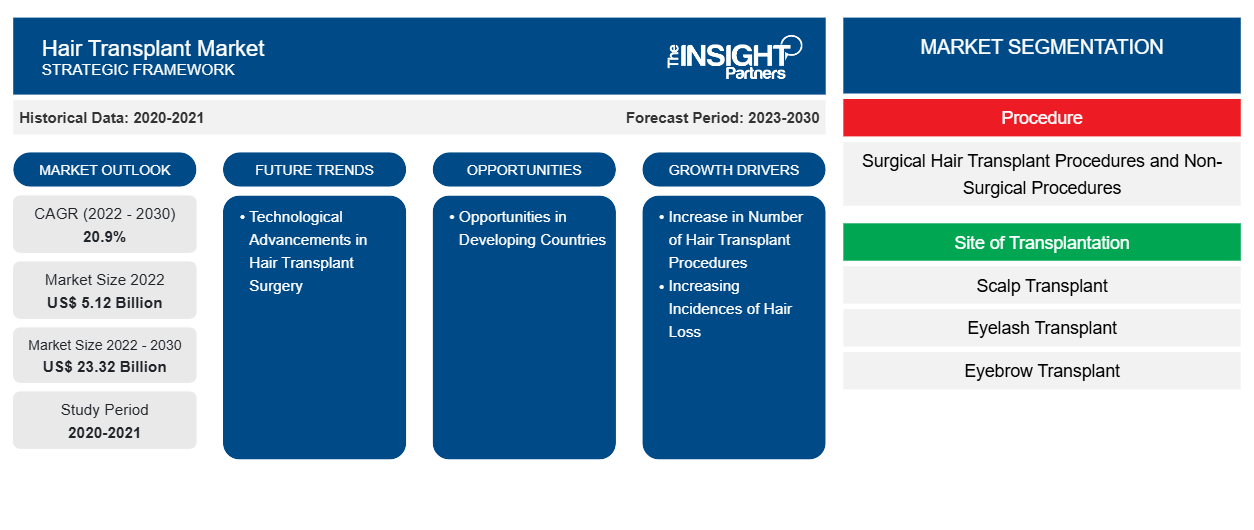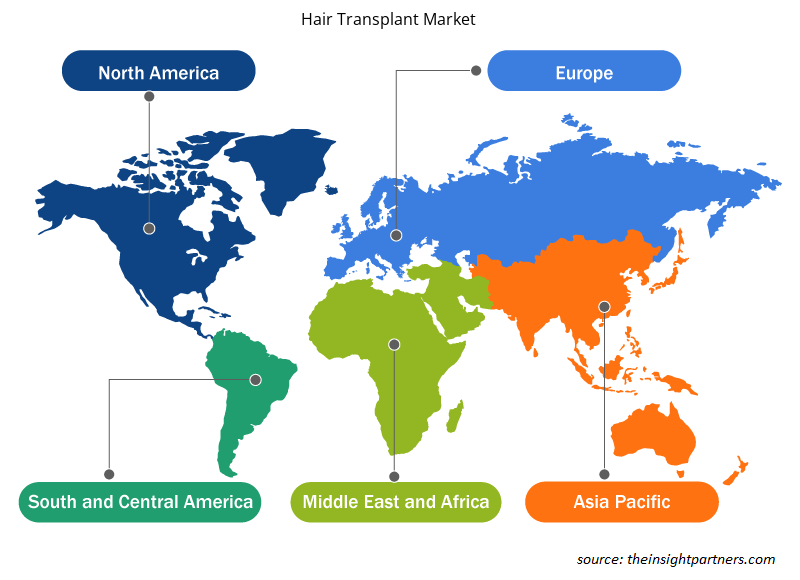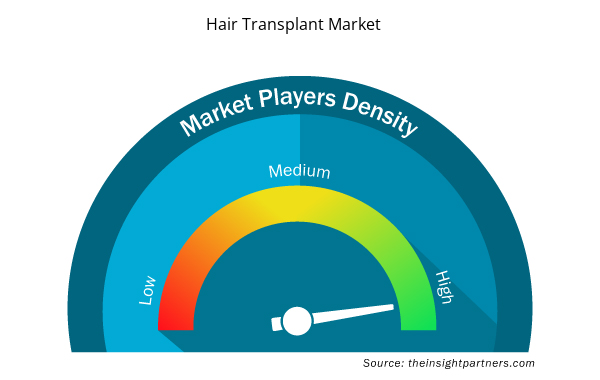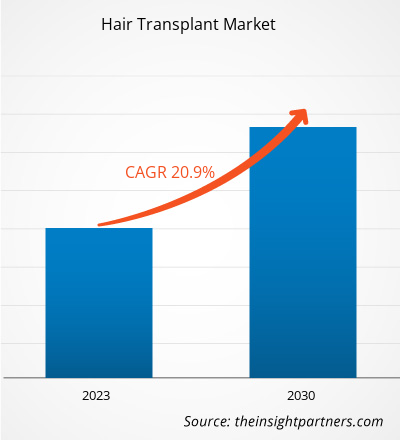[Research Report] The hair transplant market size was valued at US$ 5.12 billion in 2022 and is projected to reach US$ 23.32 billion by 2030. It is estimated to register a CAGR of 20.9% during 2022–2030.
Market Insights and Analyst View:
The hair transplant market size is increasing with the growing number of hair transplant procedures and the increase in the incidence of hair loss. Additionally, technological advancements in hair transplant procedures in the market are expected to create ample opportunities for the hair transplant market. Hair transplant surgery has come a long way in recent years due to advancements in research and technology. However, advances in hair transplant techniques have significantly affected hair transplant procedures. Robotic systems, stem cell hair loss therapy, platelet-rich plasma (PRP) therapy, ethnic hair transplants, hairline advancement, tissue expansion, and hair cloning are cutting-edge techniques in hair transplantation.
Growth Drivers and Challenges:
Hair transplant is a surgical procedure used to treat hair loss. This procedure takes place in clinics or medical offices. Factors such as pattern baldness, genetics, stress, diet, and hormonal imbalance are responsible for hair loss. Additional factors such as a history of hair loss and increasing use of medication also cause hair loss. Changing beauty standards and the growing need for hair loss treatment are creating demand for hair transplant procedures. For instance, according to the International Society of Hair Restoration Surgery (ISHRS), in 2021, an estimated 703,183 hair transplant procedures were performed globally.
Governments in developing countries are taking several initiatives to improve healthcare infrastructure and attract patients from around the world. As a result, developing countries, such as India, are gaining popularity as medical tourism destinations. The cost of a hair transplant procedure varies across the globe. Compared to the US and Australia, the cost of hair transplants in India is less. Thus, people from countries such as the US, the UK, Australia, Canada, Turkey, and Dubai prefer India as a unique destination for getting hair transplant surgery. For instance, compared to the US, where a similar number of grafts cost between US$ 3,615 and US$ 14,463, the average cost of a hair transplant surgery in India with pre-and post-operative care is between US$ 1,084 and US$ 1,807. Furthermore, the availability of highly skilled professionals and increased medical tourism for cosmetic surgery has surged the number of procedures performed in developing countries.
Customize This Report To Suit Your Requirement
You will get customization on any report - free of charge - including parts of this report, or country-level analysis, Excel Data pack, as well as avail great offers and discounts for start-ups & universities
Hair Transplant Market: Strategic Insights

- Get Top Key Market Trends of this report.This FREE sample will include data analysis, ranging from market trends to estimates and forecasts.
Customize This Report To Suit Your Requirement
You will get customization on any report - free of charge - including parts of this report, or country-level analysis, Excel Data pack, as well as avail great offers and discounts for start-ups & universities
Hair Transplant Market: Strategic Insights

- Get Top Key Market Trends of this report.This FREE sample will include data analysis, ranging from market trends to estimates and forecasts.
Several reasons, such as Telogen Effluvium (TE), drug side effects, tinea capitis, and alopecia areata, also cause hair loss. TE is a common type of hair loss caused due to severe infection and prolonged illness. For instance, as per the article published in the Journal of Medicine and Life, telogen effluvium is one of the effects of the COVID-19 pandemic. Medications and stressful circumstances brought on by COVID-19 have resulted in causing TE.
Increasing use of medications such as lithium, beta-blockers, warfarin, heparin, amphetamines, and levodopa (Atamet, Larodopa, Sinemet) can also result in hair loss. In addition, many cancer chemotherapy drugs, including doxorubicin, frequently result in rapid hair loss. Furthermore, fungal infection of the scalp is one of the major reasons for hair loss in children. According to an article published in PLOS ONE in 2023, yearly tinea capitis accounts for 25 to 30% of all infections.
The cost is a significant factor responsible for influencing the selection of treatment. The cost of a hair transplant procedure varies and depends upon several factors, such as the number and size of grafts used, the type of donor site (follicular unit transplantation or follicular unit extraction), and the stage of hair loss. The labor-intensive nature of hair transplants makes them more expensive than most cosmetic procedures. Since hair transplants require a lot of manual labor, they are more costly than most medications used for hair loss treatment. For instance, the hair transplant cost varies between US$ 3,000 to over US$ 15,000 globally. Thus, the high cost of the procedure hampers the growth of the market.
Hair transplant surgery has come a long way in recent years due to advancements in research and technology. However, advances in hair transplant techniques have significantly affected hair transplant procedures. Robotic systems, stem cell hair loss therapy, platelet-rich plasma (PRP) therapy, ethnic hair transplants, hairline advancement, tissue expansion, and hair cloning are cutting-edge techniques in hair transplantation.
Robotic hair transplantation is an automated technique that uses robotic arms, cameras, and imaging software to extract and position hair follicles. It combines the accuracy of robotics with the skill of a trained surgeon. The benefits of this method include precision, lessening of scarring, quicker healing, and natural-looking outcomes for patients. Follicular unit extraction (FUE) is a new technique that is becoming popular because it's easy to use and takes less time to heal. Direct hair implantation (DHI) is a more advanced version of FUE. It has several advantages over FUE, such as extracted follicles being implanted directly into the recipient area. This eliminates the need to make incisions in the scalp. This allows for faster healing, less scalp trauma, and more accurate placement of hair follicles. PRP is also gaining traction as a way to improve the results of hair transplants. It can help increase the amount and quality of hair transplants, leading to better results. Stem cell hair transplantation is a novel approach to hair loss that offers great potential for those with severe hair loss or restricted donor areas. There is tremendous potential for stem cell hair transplantation to revolutionize the field of hair regrowth. Thus, technological advancement in hair transplant is projected to influence market expansion positively.
Report Segmentation and Scope:
The hair transplant market is divided on the basis of procedure and site of transplant. Based on procedure, the hair transplant market is bifurcated into surgical hair transplant procedures and non-surgical procedures. The surgical hair transplant procedures segment is further bifurcated into follicular unit strip surgery (FUS), follicular unit extraction (FUE), and other surgical procedures. The non-surgical procedures segment is further divided into platelet rich plasma, laser cap, and others. Based on the site of transplantation, the hair transplant market is segmented into scalp transplant, eyelash transplant, eyebrow transplant, beard/moustache transplant, chest transplant, and other transplantations. Based on geography, the hair transplant market is segmented into North America (the US, Canada, and Mexico), Europe (the UK, Germany, France, Italy, Spain, and the Rest of Europe), Asia Pacific (China, Japan, India, South Korea, Australia, and the Rest of Asia Pacific), the Middle East & Africa (the UAE, Saudi Arabia, South Africa, and the Rest of the Middle East & Africa), and South & Central America (Brazil, Argentina, and the Rest of South & Central America).
Segmental Analysis:
Based on procedure, the hair transplant market is segmented into surgical hair transplant procedures and non-surgical procedures. The surgical hair transplant procedures segment is further bifurcated into follicular unit strip surgery (FUS), follicular unit extraction (FUE), and others surgical procedures. The non-surgical procedures segment is further classified into platelet rich plasma, laser cap, and others. A hair transplant is a commonly performed cosmetic procedure. An increase in people with genetic hair loss is projected to boost the demand for surgical hair transplant procedures. Hair transplant procedures are most common in men. For instance, according to The International Society of Hair Restoration Surgery (ISHRS), in 2022, approximately 87.3% of men and 12.7% of women underwent surgical procedures across the globe. Recent technological advancements and the concept of using follicular unit grafts have elevated the procedure to new heights. Because of its ability to produce natural results, a growing number of balding men and women opt for this surgical solution.
Based on the site of transplantation, the hair transplant market is classified into scalp transplant, eyelash transplant, eyebrow transplant, beard/moustache transplant, chest transplant, and other transplantations. In 2022, the scalp transplant segment held the largest share of the market, and the bread/moustache transplant segment is expected to register the highest CAGR during 2022–2030. Beard transplant techniques have advanced a lot in recent years. The procedure is used to correct facial areas with hair loss and to improve the appearance of existing facial hair. The procedure is typically performed on men with spotty or patchy hair loss from their goatee, other parts of their beard, sideburns, or moustache. Hair loss may be inherited or result from surgical scars, burns, or other mishaps. The beard and moustache transplant is more challenging and sophisticated because hair direction and angle change in different parts of the beard and moustache. The procedure involves harvesting scalp grafts using the FUE and DHI techniques. As a result, more experience is required. Moreover, each year, more and more people worldwide are getting a beard transplant, with an 80–90% average success rate.
Regional Analysis:
Based on geography, the hair transplant market is segmented into North America, Europe, Asia Pacific, the Middle East & Africa, and South & Central America. North America is the largest contributor to the growth of the hair transplant market, and Asia Pacific is expected to be the fastest-growing market in the coming years. The market growth in North America is attributed to an increasing focus on taking initiatives to create awareness about hair loss treatments and transplant procedures among the population. The American Academy of Dermatology declared “August” as National Hair Loss Awareness Month in the US to educate people suffering from hair loss about the causes and treatments for their problems. An increase in hair loss incidence among the American population and a rise in initiatives to create awareness about treatment and transplant procedures fuel the hair transplant market growth in North America. Medical tourism is rapidly growing in Mexico due to its proximity to the US and the availability of treatments with lower costs than the US and Canada. According to the blog “Hair Transplantation Costs by Country Going into Summer 2023” published by United Care Clinic, the average cost of 2,000 hair grafts is ~US$ 3,200 in Mexico, whereas the cost ranges from ~US$ 13,000 to ~US$ 17,000 in the US and Canada. Hence, the US and Canadian populations are focusing on carrying out hair transplant procedures in Mexico as the country provides technologically advanced and cost-effective procedures. Therefore, there is an increase in the number of hair transplant procedures in North America, which fuels the North America hair transplant market growth.
Hair Transplant Market Regional Insights
Hair Transplant Market Regional Insights
The regional trends and factors influencing the Hair Transplant Market throughout the forecast period have been thoroughly explained by the analysts at Insight Partners. This section also discusses Hair Transplant Market segments and geography across North America, Europe, Asia Pacific, Middle East and Africa, and South and Central America.

- Get the Regional Specific Data for Hair Transplant Market
Hair Transplant Market Report Scope
| Report Attribute | Details |
|---|---|
| Market size in 2022 | US$ 5.12 Billion |
| Market Size by 2030 | US$ 23.32 Billion |
| Global CAGR (2022 - 2030) | 20.9% |
| Historical Data | 2020-2021 |
| Forecast period | 2023-2030 |
| Segments Covered |
By Procedure
|
| Regions and Countries Covered | North America
|
| Market leaders and key company profiles |
Hair Transplant Market Players Density: Understanding Its Impact on Business Dynamics
The Hair Transplant Market market is growing rapidly, driven by increasing end-user demand due to factors such as evolving consumer preferences, technological advancements, and greater awareness of the product's benefits. As demand rises, businesses are expanding their offerings, innovating to meet consumer needs, and capitalizing on emerging trends, which further fuels market growth.
Market players density refers to the distribution of firms or companies operating within a particular market or industry. It indicates how many competitors (market players) are present in a given market space relative to its size or total market value.
Major Companies operating in the Hair Transplant Market are:
- Cole Instruments Inc
- Vision Medical Inc
- Bernstein Medical PC
- Curallux LLC
- HairMax Inc
Disclaimer: The companies listed above are not ranked in any particular order.

- Get the Hair Transplant Market top key players overview
Competitive Landscape and Key Companies:
Cole Instruments Inc., Vision Medical Inc., Bernstein Medical PC, Curallux LLC, HairMax Inc., NovaGenix LLC, Apira Science Inc., Theradome Inc., Robotics Restoration Inc., LaserCap Co. are a few of the prominent players operating in the hair transplant market. These companies focus on expanding service offerings to meet the growing consumer demand worldwide. Their global presence allows them to serve a large set of customers, subsequently allowing them to expand their market share.
- In 2019, the researchers from Columbia University in New York, worked on creating “hair farms” using a grid of 3D-printed plastic moulds which mimic the exact shape of hair follicles.
- In April 2021, according to the experts who presented at the American Academy of Dermatology Virtual Meeting Experience (AAD VMX) 2021 annual meeting, futuristic hair restoration techniques such as introduction of robotics, platelet-rich plasma (PRP), and photobiomodulation (low-level laser light) are leading the way.
- In February 2022, Atlas Health Medical Group announced the innovations of PRP (Platelet Rich Plasma) Microneedling Facelifts for patients. The experts at the office will be delivering the PRP microneedling facelift using the FDA approved microneedling device, the SkinPen.
- In September 2020, Stemson Therapeutics announced that the company raised US$ 7.5 million led by Allergen Therapeutics to restore human hair growth by using patients’ own cell to generate hair follicle.
- Historical Analysis (2 Years), Base Year, Forecast (7 Years) with CAGR
- PEST and SWOT Analysis
- Market Size Value / Volume - Global, Regional, Country
- Industry and Competitive Landscape
- Excel Dataset


- Water Pipeline Leak Detection System Market
- Nuclear Waste Management System Market
- Investor ESG Software Market
- Cling Films Market
- Educational Furniture Market
- Identity Verification Market
- Analog-to-Digital Converter Market
- Emergency Department Information System (EDIS) Market
- Artwork Management Software Market
- Cosmetic Bioactive Ingredients Market

Report Coverage
Revenue forecast, Company Analysis, Industry landscape, Growth factors, and Trends

Segment Covered
Procedure, Site of Transplantation, and Geography

Regional Scope
North America, Europe, Asia Pacific, Middle East & Africa, South & Central America

Country Scope
This text is related
to country scope.
Frequently Asked Questions
North America region is dominating the hair transplant market in terms of market share and Asia Pacific is anticipated to register the highest CAGR during the forecast period.
Hair transplant is a procedure in which surgeon moves the hair to bald area by using surgical and non-surgical procedures. Hair transplant can be performed for scalp, eyelash, eyebrow, beard/moustache, chest and among others sites
The hair transplant market majorly consists of the players such as Cole Instruments Inc, Vision Medical Inc, Bernstein Medical PC, Curallux LLC, HairMax Inc, NovaGenix LLC, Apira Science Inc, Theradome Inc, Robotics Restoration Inc and LaserCap Co.
The hair transplant market is analyzed on the basis of procedure and site of transplantation. Based on procedure, the market is segmented into surgical transplant procedures and non-surgical procedures. Based on site of transplantation, the market is classified as scalp transplant, eyelash transplant, eyebrow transplant, beard/moustache transplant, chest transplant and other transplantations.
The growth of the global hair transplant market is attributed to a few key factors, such as the increase in number of hair transplant procedures and increasing incidences of hair loss.
Trends and growth analysis reports related to Life Sciences : READ MORE..
The List of Companies - Hair Transplant Market
- Cole Instruments Inc
- Vision Medical Inc
- Bernstein Medical PC
- Curallux LLC
- HairMax Inc
- NovaGenix LLC
- Apira Science Inc
- Theradome Inc
- Robotics Restoration Inc
- LaserCap Co.

 Get Free Sample For
Get Free Sample For